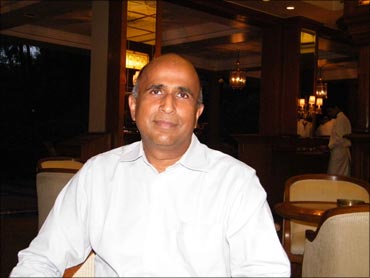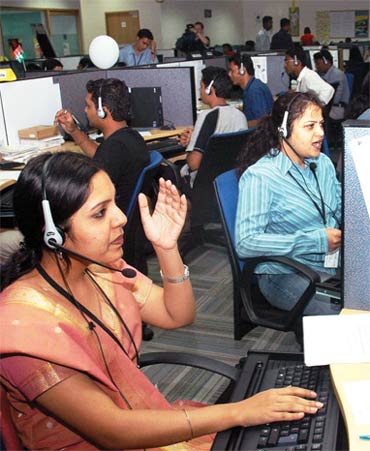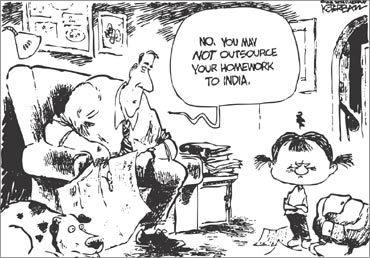 | « Back to article | Print this article |
Tutoring US students from Indian homes
Krishnan Ganesh is the founder chairman of Tutorvista and CEO of Smartthinking. Tutorvista when launched in 2006 was a unique concept; teaching or taking tuitions and helping American children in studies by Indian teachers.
He can also be described as a serial entrepreneur. His first entrepreneurial venture in 1990 was IT&T which he sold to iGate in 2003.
In 2000, he started CustomerAsset, a call centre, only to sell it to ICICI in 2002 (now known as FirstSource). From 2002 to 2007, he was the Chairman, investor and advisor in Marketics, which was later acquired by WNS.
Tutorvista teaches 20,000 students, 95 per cent of them from the United States. The rest are from 24 different countries. Ganesh plans to enter the United Kingdom, Canada and Australia next year.
Today, 80 per cent of the stake in Tutorvista is owned by the media and education giant Pearson.
In this interview, Ganesh talks about being a serial entrepreneur and also about Tutorvista.
Click NEXT to read on . . .
Tutoring US students from Indian homes
You have the serial entrepreneur tag now. Did you always want to be an entrepreneur?
Not really. After studying engineering, I started my career with Tata Motors. Then I went to do MBA from IIM-Calcutta. I worked with HCL after that. HCL, at that time, was a small company and I used to report to (HCL chairman) Shiv Nadar directly. So I had the opportunity to observe him at close quarters.
I was allowed to take decisions and when the decisions turned out to be effective, I thought why not do it on my own?
It was HCL that made me an entrepreneur. If I had joined any other company, I would not have become an entrepreneur.
You became not just an entrepreneur but a serial entrepreneur...
Entrepreneurship is an addiction. Once you get addicted to it, it is very difficult to stop. You create, you sell and you create again...
Click NEXT to read on . . .
Tutoring US students from Indian homes
When you create something, it is like your own baby. What is the feeling when you sell it?
There are things behind entrepreneurship. One is a passion for an idea. Second is the stupidity to believe that the idea will work.
If you look at it statistically, only 5 per cent of start ups succeed. Ninety-five per cent fail. Yet everyday, you see one entrepreneur after another starting a company.
Why? Because he thinks he belongs to the five per cent. So if you look at statistics, you have to be stupid enough to start.
Starting something new is difficult but running an existing company is easier. Unless you are really passionate and living with it 24 hours a day, you cannot make it succeed.
It is not about an idea but the passion for an idea that makes an entrepreneur successful.
How can an entrepreneur sell his venture if he is so passionate about it?
Yes, I have been asked this question several times. I was also asked whether I regretted selling. Yes, I did. In three out of four cases where I have sold my ventures, it was a 100 per cent voluntary. I was not forced to sell by anybody.
In the fourth, it was 50 per cent voluntary. None of them were distress sales. I sold all my ventures because I got very good deals.
To the question why I sell them, I would say, I look at my companies like products. Though I am passionate, I know that as the company grows, in its best interest, different kinds of skill sets are required. My job is to see that the value for everybody in the company is maximised and the risk, reduced.
They say entrepreneurs take risks. I don't agree. I say entrepreneurs know how to manage risks.
I always feel that an entrepreneur should not get emotionally attached to his company. The example I give in the Indian context is, you give birth to a daughter but give her away in marriage. Just because you are attached to your daughter, do you stop her from marrying? You are still her father.
Similarly, I am still the founder of First Source, Customer Asset and IT &T.
When First Source completed 10 years, I was called as the Chief Guest. So even if you sell your venture, it does not change the fact that you founded it.
Click NEXT to read on . . .
Tutoring US students from Indian homes
As an entrepreneur, when do you realise that it has to be sold?
Take the case of Customer Asset, a call centre we started in 2002. It was one of the first call centres in India. I sold it to ICICI (now named as First Source) when Wipro, IBM, Infosys, et cetera entered the call centre business.
Suddenly, the call centre environment changed from a startups to a big players' game.
Today, 300,000 people are working at night in call centres in Bengaluru. When we started, people questioned how we would get 1,000 people to work at night.
We took a very good decision at that time to sell it. Today, only big boys are there in the call centre business. If we had waited for another two years, we would not have been able to sell it.
After that, not many companies were sold in that space. So, timing is important.
How did the idea to start Tutorvista come about?
It was triggered off by a cartoon. In 2002, we started one of the first call centres. It was a novel thing for the Americans too. I was attracted by a cartoon that appeared in a newspaper.
In it, the father tells his angry son: 'No, you will not outsource your homework to India!' That was when I had sold Customer Asset and thinking of starting a new business.
The cartoon set me thinking. I wondered, why can't I do it? Outsource homework to India! That was how the idea germinated.
Click NEXT to read on . . .
Tutoring US students from Indian homes
Later when I was interviewed by an American TV channel, I told them about the cartoon. They showed the cartoon and said, 'Beware, writers and cartoonists, when you make jokes about India, you may give ideas to Indian entrepreneurs!'
After seeing the show, the cartoonist wrote to me saying he never thought his cartoon would have such an impact on someone! He also said that he felt a sense of fulfilment.
That was the start.
What kind of market research did you do?
I spoke to a lot of people. What struck me about US education was, though they are number one in higher education, produce the maximum number of Nobel laureates and maximum number of patents and have the best universities in the world, the school education system is really pathetic.
In one survey, the US is ranked 29th out of 30 countries in Maths and 27th out of 30 in Science.
It is not because teachers or schools are bad. It is because personalised education is highly unaffordable.
I then wondered why we couldn't use the Internet, technology and Indian teachers to solve the problem. That was how we started.
Click NEXT to read on . . .
Tutoring US students from Indian homes
How do students and parents in the US come to know of Tutorvista?
What we do is, we do online marketing. If someone in the US searches on Google, they come to our site. We do search-engine-optimisation. We manage over 2 million key words and when people search for those key words, Tutorvista comes first.
When a million people click our site, we get at least a thousand of them to pay money.
At $1 million in peak months, we are the largest spender on the Internet from India. Sitting here in India, we are able to create the world's largest destination site for education. That is how we succeeded.
Were you apprehensive first about people paying money for tuition online?
Yes, we were apprehensive as nobody had done this before. It is not BPO business; its consumer business. We are directly dealing with the consumers. We are the first B2C company from India across any category for the US market.
We created our own brand. What we were doing was unique. A parent in the US has to trust you, give you money and let you teach his child. It is very personal.
There is audio and chat, and both the teacher and child share the same screen.
Click NEXT to read on . . .
Tutoring US students from Indian homes
Could you raise money for the venture as you were doing it for the first time?
Despite my track record, six venture capitalists refused to invest. One person told me, 'Ganesh, we know you. Why don't you do something simple in life?'
Finally one VC funded $2 million and we invested almost all of it in marketing. Slowly, we started raising more money. We have so far raised $35 million in three rounds.
How do you recruit teachers for Tutorvista?
Once we put an ad in a paper in Bengaluru. After that, as we are covered so widely in the media in India, people started calling us. Today, we have over 6,000 applications pending for people who want to work from home.
Today, we have 2,000 teachers working for us from 123 towns and cities in India and 90 per cent of them are women. They all work from home.
We have the maximum number of teachers from Chennai followed by Hyderabad. Some of them work 4 hours a day and some, eight hours.
Click NEXT to read on . . .
Tutoring US students from Indian homes
How many students in the US take your tuitions?
We have about 20,000 students and 95 per cent of them are from the US as 100 per cent of our marketing strategy is US centric.
The rest are from 24 different countries. Next year, we are entering the UK, Canada and Australia.
Almost 30 per cent of the students are college students. About 40 per cent are high school students. The youngest is a 6-year-old and the oldest is a 65-year-old from Korea who wants to learn English.
We charge $100 per month.
How did Pearson come into the picture?
Pearson is the world's largest education company. They had two interests in Tutorvista. One, the focus is changing from content to educational services as content will remain the same.
Two, we have a very large India business. We run 24 schools. We have 60 tutorial centres in Karnataka and Kerala. We also supply educational content to 1000 schools in India. We have added all this in the last five and a half years.
Pearson's focus in the next few years is India, China and Brazil.
They had 17.2 per cent stake two and a half years back. Six months back, they increased it to 80 per cent. We hold only 20 per cent now. They will purchase the 20 per cent also in another 3 years' time.
So, you are ready to sell Tutorvista also...
Yes, that will also happen.
What is your advice to young entrepreneurs?
My advice is, entrepreneurship is a very tough and hard business but extremely satisfying and challenging too.
Think really big; don't think small. Whether you think small or big, chances of success are only 5 per cent. So think big. If you have to fail, fail spectacularly.







